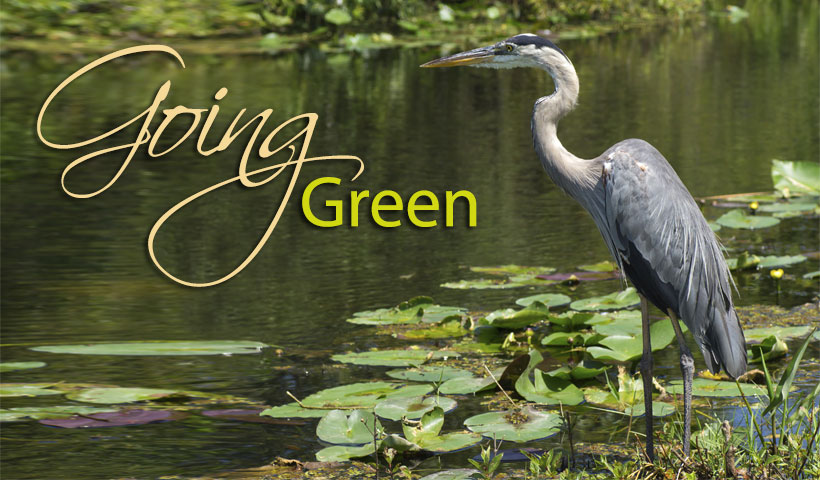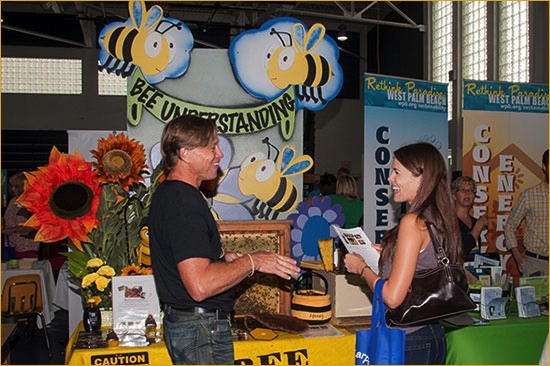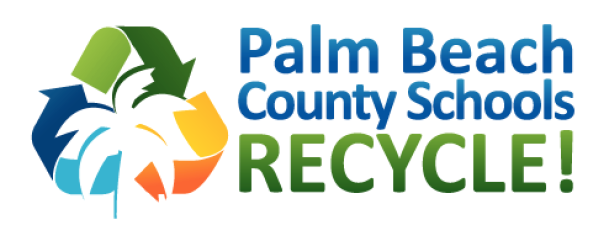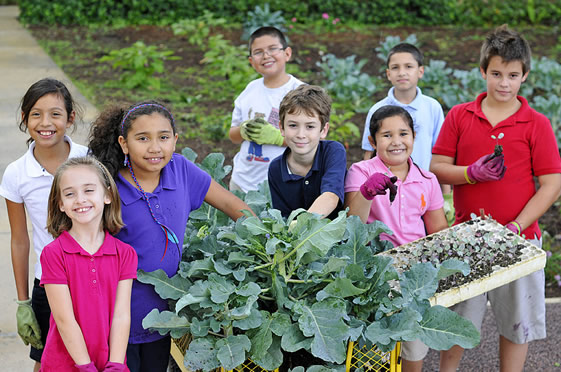

The School District takes a command role in being a good steward of the natural and built environment and is committed to the precept that conservation and resource efficiency are everyone’s responsibility. One vehicle for executing the District’s activist environmental policy is its Green Schools Initiative, involving all members of the county’s 186 schools, administration, and school communities; the initiative is led by the Division of Support Operations. The three main pillars of the Green Schools Initiative are Building Green, Learning Green, and Living Green.
The Green Schools Initiative includes activities, programs, and partnerships that build support for and underscores the need for environmental stewardship at all District levels. It also helps illustrate the important relationship between personal wellness and the health and sustainability of our one and only planet.
In 2013, the District was honored to be named a U.S. Department of Education Green Ribbon Schools District Sustainability Awardee, which was achieved largely because of the commitment to build and maintain green and healthy schools to foster high-achieving students.
Video highlighting the District’s Green Ribbon Award:
The School District of Palm Beach County is a national leader in the construction and maintenance of green schools. In May 2009, as part of a policy to encourage energy and water conservation, the District added a provision stating: “The District shall plan, design, construct, operate and maintain all new District buildings to meet the Leadership in Energy and Environmental Design (LEED) Silver certification level.” Furthermore, “The District will endeavor to make all existing District buildings LEED certified based on available resources.”
As of 2014, the School District has achieved LEED certification for eight schools by the United States Green Building Council (USGBC) and one school by the Florida Green Building Coalition. Of the eight LEED schools, four schools achieved LEED Gold, two achieved LEED Silver, and two are Certified. In addition, the department is awaiting the final rating for its newest project, Galaxy Elementary School, which is targeted to achieve a Platinum rating. If successful, it will be the first school campus in Florida to earn LEED® Platinum under USGBC's LEED for Schools 2009 certification program. Four other elementary school projects are anticipated to achieve LEED ratings as well. In the first project of its kind, the District was awarded LEED for Existing Buildings, Operations & Maintenance for Heritage Elementary School in early 2014.
Benefits of building and maintaining green schools include significant energy savings, measurable reductions in waste generation, decreased water use, and improved indoor air quality. Other benefits are less tangible and harder to demonstrate empirically, but are no less desirable. These include improvements in occupants’ health and sense of wellbeing, increased employee morale, productivity, recruitment, employee retention, and improved student achievement.
Key Fact: In August 2013, the new Galaxy Elementary School in Boynton Beach opened its doors for the first time. The 109,000-square-foot campus features solar power and will seek the highest level of LEED® green building certification possible - Platinum. Galaxy is believed to be the first school campus in Florida to target LEED® Platinum under USGBC's LEED for Schools 2009 certification program.
Another important component of the Green Schools Initiative is to provide support for all schools in their efforts to bring sustainability concepts to the campus and the classroom. In the majority of the District’s schools, students participate in green education, either through traditional classroom curriculum or “experiential” learning outside the classroom. Some of the topics covered include energy and water efficiency, waste reduction and recycling, as well as lessons about the importance of good indoor environmental quality and healthy outdoor environments.
Another mechanism used to support this concept is the Green Schools Recognition Program (GSRP), which, in 2014, celebrated its sixth year in Palm Beach County. The program recognizes and rewards schools for taking an innovative and holistic approach to going green that includes school ground enhancement, resource conservation, curriculum connections, and community involvement with a demonstrated school wide commitment and focus on sustainability.
The GSRP is coordinated by the Florida Atlantic University - Pine Jog Environmental Education Center in collaboration with The School District of Palm Beach County and was launched in 2008 with support from the Community Foundation for Palm Beach and Martin Counties.
On May 9, 2014, 70 public and private schools in Palm Beach and Martin Counties that have made the grade in “going green” during this school year celebrated their efforts at the sixth annual Green Schools Awards Luncheon held in their honor at the West Palm Beach Marriott.
The Green Schools Recognition Program (GSRP) recognizes schools for taking a holistic and innovative approach to going green that incorporates school ground enhancement, resource conservation, curriculum connections, and community involvement with a school-wide commitment and focus on sustainability. The GSRP is coordinated by the Florida Atlantic University’s Pine Jog Environmental Education Center in collaboration with the School Districts of Palm Beach and Martin Counties and with the support of a host of community partners including the Solid Waste Authority of Palm Beach County, Florida Power & Light, Florida Department of Transportation’s SchoolPool, Audubon Society of the Everglades, City of West Palm Beach Office of Sustainability, The Resource Depot, Growums, UnitedHealthcare, and the South Florida Science Center and Aquarium. The GSRP was launched in 2008 with support from the Community Foundation for Palm Beach and Martin Counties.
Recognition was given to 13 “Green Schools of Promise,” 24 “Green Schools of Quality,” and 33 “Green Schools of Excellence.” These levels illustrate that “going green” is a journey, and that schools should be acknowledged for their efforts along the way.
The top Green Schools were announced at the luncheon:
- default_title1st Place - Pine Jog Elementary School received a cash award of $2,000.
- default_title2nd Place - Limestone Creek Elementary School received a cash award of $1,000.
- default_title3rd Place Tie - Timber Trace Elementary School and St. Vincent Ferrer Catholic School each received $750.
- Show More
"Judges Choice Awards” by category:
- default_titleAudubon Society of the Everglades: Habitat Improvement $500 - Jupiter Middle
- default_titleCity of West Palm Beach: Green your WPB School $500 - Northboro Elementary
- default_titleFlorida Power and Light: Energy Savings $500 - Dr. David Anderson Middle
- default_titleGrowums: Gardening $500 - Benoist Farms Elementary
- default_titleHealthy Kids, Healthy Communities: Health and Wellbeing $500 - Greenacres Elementary
- default_titleSouth Florida Commuter Services School Pool: Transportation $500 - Limestone Creek Elementary
- default_titleSouth Florida Science Center and Aquarium: Curriculum Integration $500 - Elbridge Gale Elementary
- default_titleSolid Waste Authority of Palm Beach County: Solid Waste Reduction and Conservation $500 - Jerry Thomas Elementary
- default_titleAnonymous Donor: Community Involvement $500 - Royal Palm School
- default_titlePine Jog Environmental Education Center of Florida Atlantic University: $500 for each - Mentoring: Eagles Landing Middle, Green Fundraising: Equestrian Trails Elementary, Student Initiative: Martin County High, Gardening: Felix A. Williams Elementary
- default_titleUnited Healthcare: Health and Wellbeing $250 - The Pine School
- Show More
In all, $12,500 was awarded to schools that demonstrated exceptional leadership as models for implementing green school programs and practices. All cash awards were given to help these schools continue to grow their “green” projects.
For the first time, a Green Teacher of the Year was named. April Spatara of Jerry Thomas Elementary School, nominated by her school, was awarded $500. Runner ups included Cassandra Kenski of Grassy Waters Elementary School, Missy O’Connor of Hobe Sound Elementary School and Lisa Zern of Jupiter Middle School.
On November 11, 2013, the fifth annual LEARN GREEN conference was held on the campus of Alexander W. Dreyfoos School of the Arts in West Palm Beach. The conference included a one-day forum of workshops and exhibits that provided opportunities for school staff, parents, administrators, and students to learn how to “go green” at school and at home. Approximately 90 exhibitors and nearly 900 participants from the local community and representing public and private schools throughout the state of Florida attended this conference in 2013. The strong underlying message of the conference was, “You don’t need to have a green school building to build a green school!”

Nearly 900 attendees and 90 exhibitors filled the gymnasium of A.W. Dreyfoos School of the Arts during the 2013 Learn Green Conference and Expo.
Here, exhibitor Al Salopek of the not-for-profit, Bee Understanding, shares his knowledge about local honey bee populations.
A final component of the Green Schools Initiative is the application and integration of sustainability concepts into the District’s daily operations. Specifically, the District works to reduce its consumption of natural resources, reduce waste generation, increase reuse and recycling rates, manage school environments to achieve healthier indoor air quality, and build institutional capacity for sustainability.
The School District currently has a very robust recycling program, which includes paper, cardboard, mixed commingled materials (plastic, glass, aluminum, and drink containers), ink and toner cartridges, electronics (“e-waste”), some food packaging, empty glue sticks, shoes and clothes, rechargeable batteries, and scrap metal. Some schools even compost organic waste onsite and use as material to fertilize their gardens.

Some of the Green School Initiative’s measureable outcomes include a reduction of its overall electrical usage and expenses, even as new buildings and square footage have increased. Innovative practices and aggressive policies have resulted in the District achieving an overall reduction of 24.2% in energy usage and savings of over $17.5 million from fiscal year 2008 to fiscal year 2013. Each year, on average, robust recycling results in the diversion of more than 700 tons of mixed plastic, glass, and aluminum and 6,000 tons of paper products from the landfill, saving over $550,000 in disposal fees. The District also collects yearly recycling rebates of over $16,000 for electronics waste, $15,000 for paper, and almost $9,000 for ink & toner cartridges and cellular phones.
In an effort to achieve healthier indoor air quality (IAQ) in schools, staff from the Environmental & Conservation Services (ECS) department conduct assessments and abate sources of air quality concerns. The District’s IAQ program was recently recognized by the United States Department of Education through their national 2013 Green Ribbon Schools award.
In a continued effort to enhance its energy conservation program, the District employed a unique combination of strategies, resulting in an overall reduction in energy usage of 5 million kilowatt-hours, or 1.6%, in fiscal year 2014 compared to fiscal year 2013, taking weather adjustments into account. Schools who reduced their individual energy consumption received cash rewards through the District's Energy Conservation Incentive Program, which awarded 13 schools with a total of approximately $15,000, to be utilized by their school advisory councils.
Individual schools implemented many new sustainable practices and participated in projects that enhanced their environmental wellbeing. Among other projects, schools installed vegetable, butterfly, and hydroponic fruit gardens, instituted innovative recycling programs, created “green” curriculum connections, and engaged the greater school community in their sustainability efforts.

Gardening is a key component of many schools' "green" initiatives.
The District constantly surveys the horizon for new opportunities to improve operations, while maintaining high standards for academic achievement and student engagement. The Division of Support Operation’s LEED-accredited professionals and front-line employees alike have propelled the District into the national spotlight and continue to serve as a model for other organizations interested in environmental stewardship and investing in the future.
District staff work to achieve strong collaborations within the organization, as well as with community partners, to achieve the many goals of a green schools program and shared the philosophy that you need not have a green school building in order to build a green school! It is the department's belief that all schools can achieve great green strides through careful planning, maintenance and operation, thoughtful integration of environmental principles into the core curriculum, and strong belief in the idea that all children deserve healthy schools to give them the best chance of being high-achieving students.
